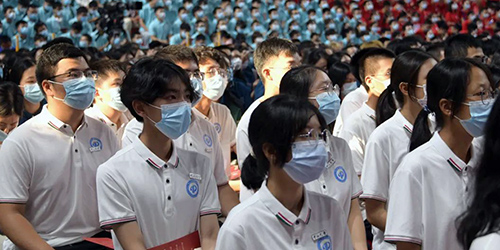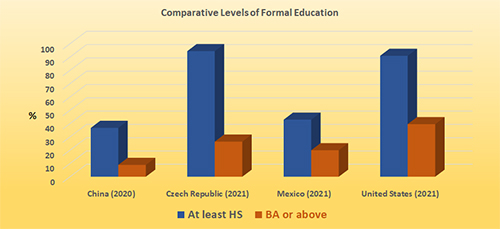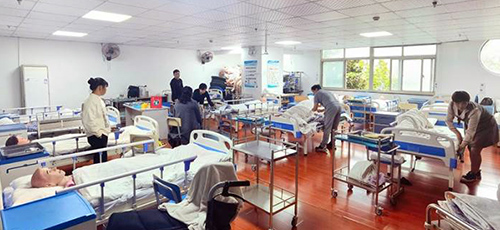Happy Lunar New Year from the USC US-China Institute!
Learning beyond school

Young people are heading back to school in the United States and China. In the U.S., more than 51 million students will be in primary, secondary or undergraduate programs. In China, more than 220 million will be in such programs. In both countries education is seen as expanding economic opportunities for individuals and powering national economic advance. To meet its need for a better educated workforce, China dramatically increased higher educational opportunities. Today China has more university students than the U.S.
New students join the school-opening ceremony at Sun Yat-sen University in Guangzhou, 2022.
But many newly minted degree holders find it difficult to secure employment. This is attributed to a mismatch in what the market wants and what students have studied, a desire on the part of students to stay in the biggest cities, problems for some business sectors and an overall economy that is slowing. Two-thirds of college students say they didn’t have sufficient career information when they chose their majors. Last year, the government had schools expand graduate school slots to absorb a larger share of new grads. This year, universities are under pressure to get students placed in jobs. An increasing number of people are seeking lower-paying, but more secure jobs in government or state enterprises. Much of this sounds familiar to students in America and to their families.

Job fair at Hangzhou Normal University, Nov. 2022.

From gwy.com, a company providing civil service examination preparation help.
China’s Ministry of Education reports that over 91% of senior high age people in China are attending school (including vocational schools), but as with the ramp up in universities, this is relatively recent and masks a low graduation rate for rural youth. In 2020, only 37% of the population age 25 to 64 had received a high school diploma or equivalent. In the more developed countries of the Organization for Economic Cooperation and Development (OECD), the average is 83%. The situation is similar at the college level. The number of schools and enrollment has grown dramatically since the 1980s and 1990s when China had between two and four million college students. But even so, just 10% of China’s 25-64 year old population has at least a bachelor’s degree. It’s 33% across the OECD and almost 40% in the U.S.

OECD data - portion of the population age 25-64, USCI chart
China’s population is so large, of course, that its educated workforce is huge, supporting the world’s second largest economy. China’s now the world’s largest exporter of vehicles and plays a pivotal role in the production of smartphones, computers and other high-tech goods. Still, increasing productivity and incomes requires a more fully educated workforce. A recent comparison of China’s educational outcomes with other nations, grouped it with nations such as Brazil, Ghana, Indonesia, Mexico and Tunisia rather than with countries with higher per capita incomes. Unequal access to education still plagues China and hampers its advance.
In 2021, McKinsey, a consulting firm, estimated that almost a third of China’s workforce, 220 million people, will be forced by automation to find new jobs by 2030. Strengthening practical training within schools is necessary, but the bulk of skill development will need to happen outside the traditional educational system. Some companies and local governments have created such training programs, but much more is required. McKinsey noted that the number of vocational schools had fallen by a third over the previous decade and that over time, Chinese workers become less focused on acquiring skills. It recommends several measures, including expanding the number of vocational schools, increasing the quality of teachers and paying them well, pointing at the example of Germany where vocational teachers earn more than those in secondary schools.

Training program in Shanghai's Pudong district for careers in elder care.
The trend towards focusing on skills mastered rather than formal degrees has not been embraced in many places, in part because it can be harder to screen for and assess. But LinkedIn argues skills-first hiring will become the gold standard.” It notes that even in advanced economies an increasing share of job postings on its predominately white-collar platform do not require a bachelor’s degree.
So, should the tens of millions of people in China and the U.S. starting college this fall reconsider and head to the nearest vocational school? Probably not. In the U.S., the median income for those with bachelor’s degrees in 2020 was $56,900. Those with high school diplomas had a median income of $36,600. This income gap may be higher in China. It is clear, however, that it will be the skills one has and one’s ability to continually master new ones that will determine a person’s opportunities regardless of academic degrees.
The featured photo above is from a July 2023 agricultural training program in Anhui Province.
RESOURCES
The USC U.S.-China Institute focused on China's educational and other challenges in our 2018 conference Finding Solutions.
The problems with education inequality are long-standing. Here's a presentation by Tsinghua University's Li Hongbin from our 2011 conference on the Chinese economy.
In 2021, Scott Rozelle discussed his book Invisible China which highlights how too many Chinese are inadequately educated and that this shortcoming could prevent China from escaping the middle-income trap.
Some young people say that there's no opportunity for them, so they are lying flat (躺平 tǎngpíng) or they say "let it rot" (摆烂 bǎilàn)。
Click here to subscribe to the USCI newsletter. It includes information about upcoming events, professional development opportunities, and quick looks at important issues in U.S.-China relations and trends in contemporary China. Previous issues are available here.
Featured Articles
We note the passing of many prominent individuals who played some role in U.S.-China affairs, whether in politics, economics or in helping people in one place understand the other.
Events
Ying Zhu looks at new developments for Chinese and global streaming services.
David Zweig examines China's talent recruitment efforts, particularly towards those scientists and engineers who left China for further study. U.S. universities, labs and companies have long brought in talent from China. Are such people still welcome?






